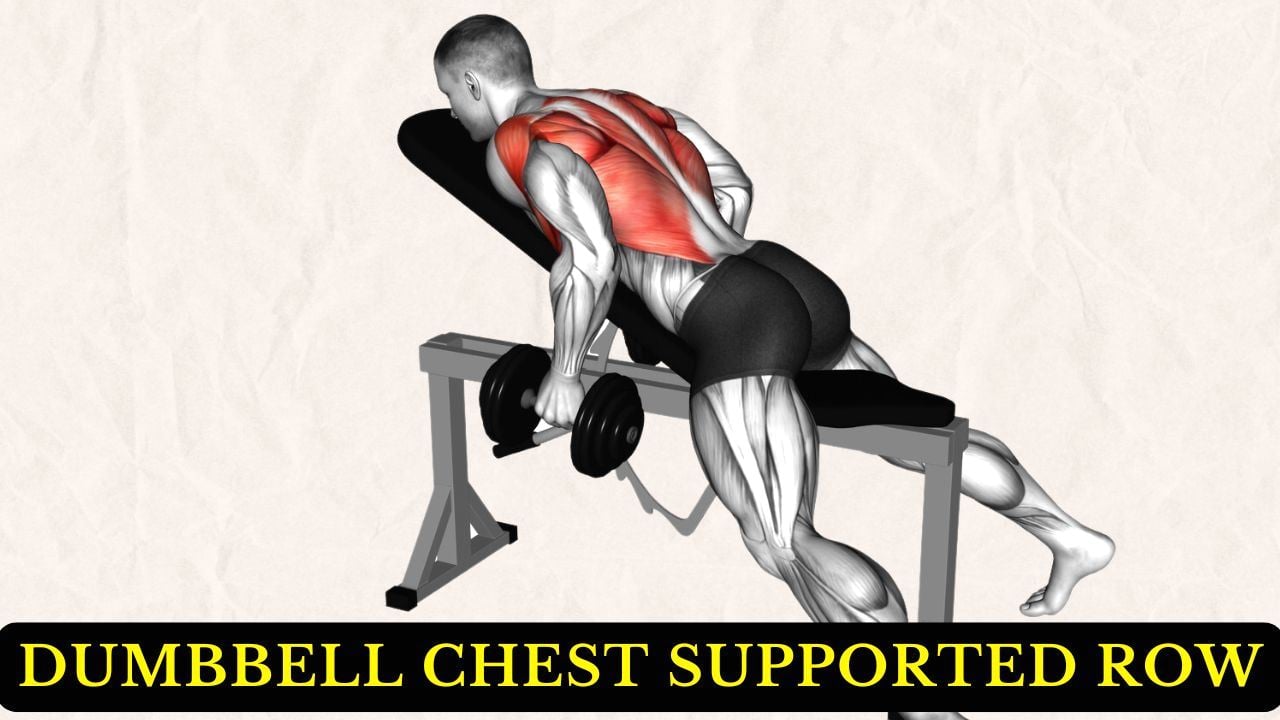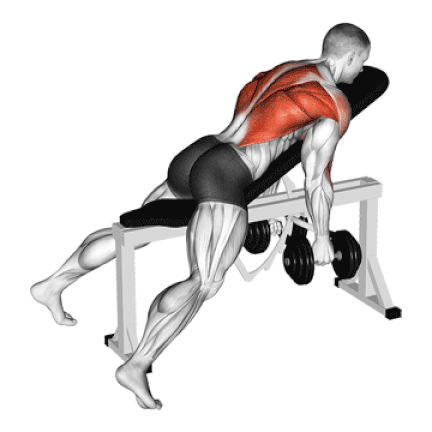The dumbbell chest supported row is a great way to work your back muscles without straining your lower back.
When your chest is supported, you can focus fully on squeezing your lats, rhomboids, and traps.
It’s also a great way to ensure strict form since there’s no room for swinging or momentum, just pure muscle engagement.
There are many advantages of doing chest-supported row exercises using dumbbells, such as:
- Dumbbells require more balance than barbells or machines, which can lead to greater muscle fibre recruitment.
- Dumbbells let you move each arm separately, which helps even out any muscle imbalances and also allows unilateral training.
- It provides a greater level of variety, which helps prevent physical and mental burnout.
- Dumbbell row variations allow for a greater range of movement (ROM).
A slight disadvantage may be difficulty breathing with heavy loads.
Let’s know how to do it correctly.

Dumbbell Chest Supported Row Muscles Worked
The dumbbell chest-supported row is a compound exercise, which means that it activates various muscle groups.
- Primarily Muscles Worked: Latissimus dorsi, Rhomboids and Trapezius muscle groups.
- Secondary Muscles Worked: Biceps, brachialis, rear deltoid, Brachioradialis, Teres Major and Minor.
- Stabilizing Muscles Worked: Erector Spinae, Core muscles (including Rectus Abdominis, Transverse Abdominis), forearms, Rotator Cuff muscles.
How To Do Neutral Grip Chest-Supported Row
- Adjust an incline bench to a 30-45 degree angle. This angle is optimal for targeting your back muscles while providing support.
- Lie face down on the bench, with your chest comfortably resting on an incline bench. Let the dumbbells hang straight down, arms fully extended.
- Hold a dumbbell in each hand, arms hanging directly down towards the floor, palms facing each other.
- Engage your core and keep your feet on the ground for stability.
- Pull the dumbbells up towards your ribcage, bending your elbows and keeping them close to your body. Aim to form a 90-degree angle at the top of the movement.
- At the peak of the row, pause for a moment and squeeze your shoulder blades together to maximize muscle engagement.
- Slowly lower the dumbbells back to the starting position and fully extend your arms without letting your shoulders round forward.
- Repeat 8–12 reps and do 3–4 sets (Total).
Tips and Form
- You should keep your spine neutral when you position yourself on the bench. This means your head, neck, and back should be in alignment.
- Before you begin the row, actively engage your core muscles. Think of pulling your belly button towards your spine.
- Exhale as you pull the dumbbells towards you and inhale as you lower them. This helps with muscle contraction and keeps you focused and in control.
- When pulling the weight towards you, do not hyperextend your spine by lifting your upper torso off the bench. You can extend slightly, but not too much.
- Perform the row with controlled, deliberate motions. Avoid jerking or using momentum, as this diminishes muscle activation. Also, focus on the eccentric phase of each repetition to get the most out of each one.
- As you pull the dumbbells towards your ribcage, think about driving your elbows back rather than just lifting the weights. This cue helps engage the lats more effectively and avoids unnecessary shoulder elevation (shrugging) that can detract from muscle activation
- Focus on retracting your shoulder blades (squeezing them together) at the top of the movement, and protracting them fully when lowering the weights.
- Choose your grip wisely—overhand, underhand, or neutral. Each grip emphasizes different muscle groups; for instance, a neutral grip can focus more on the rear deltoids while reducing bicep activation.

References
- Fenwick CM, Brown SH, McGill SM. Comparison of different rowing exercises: trunk muscle activation and lumbar spine motion, load, and stiffness. J Strength Cond Res. 2009 Mar;23(2):350-8. doi: 10.1519/JSC.0b013e3181942019. PMID: 19197209.

Manish is a NASM-certified fitness and nutrition coach with over 10 years of experience in weight lifting and fat loss fitness coaching. He specializes in gym-based training and has a lot of knowledge about exercise, lifting technique, biomechanics, and more.
Through “Fit Life Regime,” he generously shares the insights he’s gained over a decade in the field. His goal is to equip others with the knowledge to start their own fitness journey.
